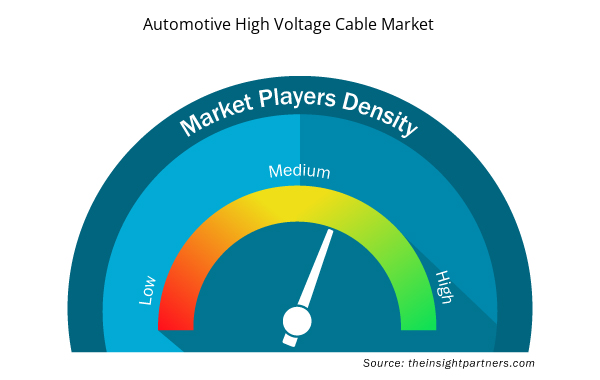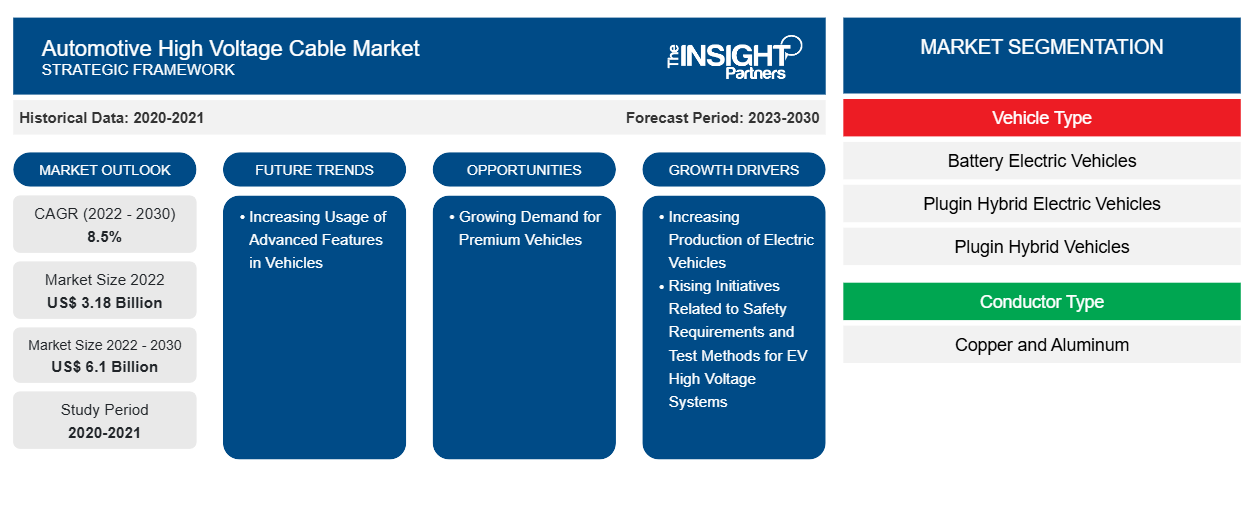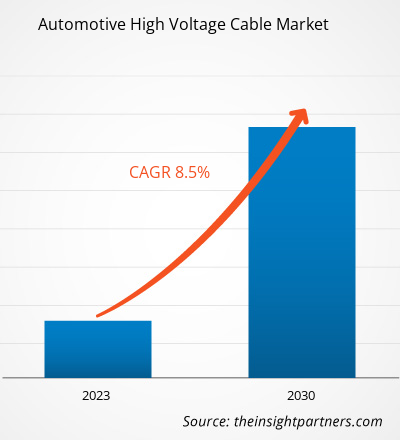[研究报告] 汽车高压电缆市场规模预计将从 2022 年的 31.7629 亿美元增至 2030 年的 61.0094 亿美元,2023 年至 2030 年的复合年增长率预计为 8.5%。
分析师观点
汽车高压电缆制造商正致力于推出创新功能和进步,以满足电动汽车用户不断变化的需求,包括获得安全和质量认证、开发延长电缆以提高便利性,以及采用液体冷却等技术来提高效率。这些趋势凸显了该行业致力于提供高性能和耐用的电缆,以满足不断发展的电动汽车市场的需求。世界各国政府正在实施政策和法规,以促进电动汽车的普及和减少碳排放,从而创造有利的市场环境。电缆设计和制造工艺的技术进步进一步促进了汽车高压电缆市场的增长。
汽车高压电缆市场概览
近年来,汽车高压电缆市场经历了显著的增长和演变。在汽车行业,高压电缆在实现高压电力传输方面发挥着至关重要的作用。全球对电动汽车的需求不断增长,推动了对高效可靠的汽车高压电缆的需求,以支持汽车的电气化。政府和监管机构也在支持向更清洁的交通方式过渡,增加电动汽车的生产和销售。政府和私营实体正在对电动汽车制造进行大量投资。随着对电动汽车的需求不断增长,对汽车高压电缆的需求也在增加。随着汽车高压电缆市场的扩大,老牌企业和新进入者都在投资研发、战略伙伴关系和产品创新。制造商之间的竞争推动了电缆技术的进步,从而产生了更安全、性能更高的最终产品。由于政府的支持性举措以及对可持续交通和竞争格局的重视程度不断提高,汽车高压电缆市场预计将在未来实现大幅增长。
定制此报告以满足您的需求
您可以免费定制任何报告,包括本报告的部分内容、国家级分析、Excel 数据包,以及为初创企业和大学提供优惠和折扣
- 获取此报告的关键市场趋势。这个免费样品将包括数据分析,从市场趋势到估计和预测。
汽车高压电缆市场驱动因素
电动汽车产量增加推动汽车高压电缆市场
电动汽车(EV) 依赖于大功率电机和大容量电池,因此需要使用高压电缆进行电力传输。这些电缆具有充电速度更快、传输大功率、改善电压调节、减少电压下降和最大限度减少功率损耗等优势。EVOLVE 项目等计划已经建立,以支持对电动汽车日益增长的需求。2023 年 6 月,印度小型工业发展银行 (SIDBI) 与 Niti Aayog、世界银行、韩国-世界银行伙伴关系基金和韩国经济发展合作基金合作,为微型和中小型企业 (SME) 提供资金,用于在印度生产 50,000 辆电动汽车。2022 年 3 月,摩洛哥宣布与五家汽车电缆供应商达成价值 1.8 亿美元的投资协议,以满足电动汽车制造商对汽车线束系统日益增长的需求。高压电缆在实现高效电力传输方面发挥着至关重要的作用。电动汽车的日益普及推动了电力使用及其传输,从而刺激了对汽车高压电缆的需求。因此,电动汽车产量的增加促进了汽车高压电缆市场的增长。
汽车高压电缆市场报告细分和范围
“汽车高压电缆市场”根据车辆类型、导体类型、芯线类型和地理位置进行细分。根据车辆类型,汽车高压电缆市场分为纯电动汽车 (BEV)、插电式混合动力电动汽车 (PHEV) 和纯电动汽车 (BEV)。根据导体类型,汽车高压电缆市场分为铜和铝。根据芯线类型,汽车高压电缆市场分为多芯和单芯。根据地理位置,自动导引车(AGV) 市场分为北美、欧洲、亚太地区、中东和非洲以及南美。
汽车高压电缆市场细分分析
根据车辆类型,全球汽车高压电缆市场细分为纯电动汽车 (BEV)、插电式混合动力电动汽车 (PHEV) 和混合动力电动汽车(HEV)。纯电动汽车 (BEV) 细分市场在 2022 年占据了最大的市场份额。BEV 完全依靠电池供电来驱动电动机,使其成为传统内燃机的环保替代品。随着对 BEV 的需求不断增长,对高压电缆的需求也相应增加,以将电力从电池传输到电动机。在 BEV 中使用高压电缆至关重要。这些电缆有助于高效传输电能,确保车辆平稳可靠地运行。它们能够传输为电动机供电的高电流和电压,提供所需的扭矩和加速度。BEV 提供零排放移动性,显着减少温室气体排放和对化石燃料的依赖。政府法规和促进电动汽车的激励措施,加上消费者环保意识的提高,正在推动对 BEV 的需求。所有这些因素都促进了纯电动汽车细分市场的汽车高压电缆市场增长。
汽车高压电缆市场区域分析
2022 年北美汽车高压电缆规模价值 4.3039 亿美元,预计到 2030 年将达到 7.7504 亿美元;预计 2023-2030 年的复合年增长率为 7.6%。北美汽车高压电缆市场分为美国、加拿大和墨西哥。2022 年,美国占据北美汽车高压电缆市场的最大份额。根据国际清洁交通委员会 2021 年的报告,2018 年至 2020 年,该市场每年销售超过 315,000 辆汽车。在美国,98% 的电动汽车都已售出。特斯拉 Model 是销量最高的车型,2020 年新销量约为 96,000 辆,其次是特斯拉 Model Y,销量为 75,000 辆,雪佛兰 Bolt 销量约为 21,000 辆。美国电动汽车组装量约为 230 万辆,而美国以外的组装量为 1800 万辆。根据同一报告,到 2025 年,电动汽车将占全球轻型电动汽车产量的 10% 左右。高压电缆广泛应用于电动汽车。多家公司正在扩大其产品供应。例如,2022 年,Coroflex 与 IEWC 合作,扩大了美国的高压电缆产品供应。因此,随着电动汽车需求的增加,汽车高压电缆市场也在增长。
汽车高压电缆市场关键参与者分析
汽车高压电缆市场由 JYFT、ACOME Group、HUBER+SUHNER、Prysmian、LEONI AG、Coroplast Fritz MÜller GmbH & CO. KG、Champlain Cable Corporation、住友电气工业株式会社、上海凯美凯电缆集团有限公司和 ZMS Cables 等参与者组成。
汽车高压电缆市场区域洞察
Insight Partners 的分析师已详细解释了预测期内影响汽车高压电缆市场的区域趋势和因素。本节还讨论了北美、欧洲、亚太地区、中东和非洲以及南美和中美洲的汽车高压电缆市场细分和地理位置。

- 获取汽车高压电缆市场的区域特定数据
汽车高压电缆市场报告范围
| 报告属性 | 细节 |
|---|---|
| 2022 年市场规模 | 31.8亿美元 |
| 2030 年市场规模 | 61亿美元 |
| 全球复合年增长率(2022 - 2030 年) | 8.5% |
| 史料 | 2020-2021 |
| 预测期 | 2023-2030 |
| 涵盖的领域 | 按车辆类型
|
| 覆盖地区和国家 | 北美
|
| 市场领导者和主要公司简介 |
|
汽车高压电缆市场参与者密度:了解其对业务动态的影响
汽车高压电缆市场正在快速增长,这得益于终端用户需求的不断增长,这些需求源于消费者偏好的不断变化、技术进步以及对产品优势的认识不断提高等因素。随着需求的增加,企业正在扩大其产品范围,进行创新以满足消费者的需求,并利用新兴趋势,从而进一步推动市场增长。
市场参与者密度是指在特定市场或行业内运营的企业或公司的分布情况。它表明在给定市场空间中,相对于其规模或总市场价值,有多少竞争对手(市场参与者)存在。
在汽车高压电缆市场运营的主要公司有:
- 复合薄膜晶体管
- 阿科姆公司
- 德国 Huber+Suhner 公司
- 普睿司曼公司
- 莱尼集团
免责声明:上面列出的公司没有按照任何特定顺序排列。

- 了解汽车高压电缆市场顶级关键参与者概况
最新动态
汽车高压电缆市场中的公司大量采用并购等无机和有机战略。以下列出了一些近期汽车高压电缆市场的发展情况:
- 2023 年 4 月,莱尼集团将其 AM 业务集团升级为汽车电缆解决方案 (ACS) 部门,凸显了汽车电缆业务在其电缆领域中的重要性。ACS 拥有全球生产网络和多样化的产品组合,是标准汽车、特殊和充电电缆的市场领导者。该部门的成功归功于其敬业的员工队伍和对汽车行业大趋势的关注。随着需求的不断增长,ACS 继续扩大生产能力,旨在为电动汽车、高压电缆、数据电缆和传感器电缆提供创新解决方案,满足不断增长的汽车高压电缆市场的需求。
- 2022 年 7 月,ACOME 在 SIA 动力传动与能源活动上展示了其在汽车行业的最新创新。它推出了一系列新的高压电源线,采用其专有的 E 层技术、Twinskin 和 Datacables。这些进步使 ACOME 成为汽车高压电缆市场的关键参与者。
- 2021 年 11 月,ACOME 在斯图加特电动和混合动力汽车技术博览会上展示了其在汽车行业的最新创新成果。该公司展示了其全新系列的高速数据和 E-Layer 电缆,巩固了其在汽车高压电缆市场的领先供应商地位。
- 2020 年 11 月,HUBER+SUHNER 推出了 RADOX 屏蔽 FLEX 电缆系列,向高压电缆市场推出了最新产品。这些电缆将成熟的 RADOX 技术与新的导体设计相结合,为电动汽车应用提供了更高的灵活性和易于安装的特性。这些电缆可抵抗各种环境因素,并符合汽车电缆标准。HUBER+SUHNER 旨在提供便利性、多功能性和可靠性,以满足行业日益增长的需求。
- 历史分析(2 年)、基准年、预测(7 年)及复合年增长率
- PEST 和 SWOT 分析
- 市场规模价值/数量 - 全球、区域、国家
- 行业和竞争格局
- Excel 数据集


- Hot Melt Adhesives Market
- Redistribution Layer Material Market
- Emergency Department Information System (EDIS) Market
- Electronic Health Record Market
- Vessel Monitoring System Market
- Dairy Flavors Market
- Automotive Fabric Market
- Oxy-fuel Combustion Technology Market
- Nitrogenous Fertilizer Market
- Vaginal Specula Market

Report Coverage
Revenue forecast, Company Analysis, Industry landscape, Growth factors, and Trends

Segment Covered
This text is related
to segments covered.

Regional Scope
North America, Europe, Asia Pacific, Middle East & Africa, South & Central America

Country Scope
This text is related
to country scope.
常见问题
The key players, holding majority shares, in automotive high voltage cable market includes LEONI Kabel GmbH, COFICAB Group, Prysmian Group, Coroplast Fritz Müller GmbH & Co. KG and HUBER+SUHNER.
Increasing production of electric vehicles and increasing initiatives related to safety requirements and test methods for EV high voltage systems are the major factors that propel the automotive high voltage cable market.
The global automotive high voltage cable market was estimated to be US$ 3176.29 million in 2022 and is expected to grow at a CAGR of 8.5 % during the forecast period 2023 - 2030.
The automotive high voltage cable market is expected to reach US$ 6100.94 million by 2030.
Increasing usage of advanced features in vehicles is anticipated to play a significant role in the automotive high voltage cable market in the coming years.
The incremental growth expected to be recorded for automotive high voltage cable market during the forecast period is US$ 2,924.65 million.
Trends and growth analysis reports related to Automotive and Transportation : READ MORE..
The List of Companies - Automotive High Voltage Cable Market
- JTFT
- Acome Co.
- Huber+Suhner AG
- Prysmian SpA
- Leoni AG
- Coroplast Fritz Muller GmbH & Co KG
- Champlain Cable Corp
- Sumitomo Electric Industries Ltd
- Shanghai KMCable Group Co Ltd
- Gebauer & Griller Kabelwerke GesmbH
The Insight Partners performs research in 4 major stages: Data Collection & Secondary Research, Primary Research, Data Analysis and Data Triangulation & Final Review.
- Data Collection and Secondary Research:
As a market research and consulting firm operating from a decade, we have published and advised several client across the globe. First step for any study will start with an assessment of currently available data and insights from existing reports. Further, historical and current market information is collected from Investor Presentations, Annual Reports, SEC Filings, etc., and other information related to company’s performance and market positioning are gathered from Paid Databases (Factiva, Hoovers, and Reuters) and various other publications available in public domain.
Several associations trade associates, technical forums, institutes, societies and organization are accessed to gain technical as well as market related insights through their publications such as research papers, blogs and press releases related to the studies are referred to get cues about the market. Further, white papers, journals, magazines, and other news articles published in last 3 years are scrutinized and analyzed to understand the current market trends.
- Primary Research:
The primarily interview analysis comprise of data obtained from industry participants interview and answers to survey questions gathered by in-house primary team.
For primary research, interviews are conducted with industry experts/CEOs/Marketing Managers/VPs/Subject Matter Experts from both demand and supply side to get a 360-degree view of the market. The primary team conducts several interviews based on the complexity of the markets to understand the various market trends and dynamics which makes research more credible and precise.
A typical research interview fulfils the following functions:
- Provides first-hand information on the market size, market trends, growth trends, competitive landscape, and outlook
- Validates and strengthens in-house secondary research findings
- Develops the analysis team’s expertise and market understanding
Primary research involves email interactions and telephone interviews for each market, category, segment, and sub-segment across geographies. The participants who typically take part in such a process include, but are not limited to:
- Industry participants: VPs, business development managers, market intelligence managers and national sales managers
- Outside experts: Valuation experts, research analysts and key opinion leaders specializing in the electronics and semiconductor industry.
Below is the breakup of our primary respondents by company, designation, and region:

Once we receive the confirmation from primary research sources or primary respondents, we finalize the base year market estimation and forecast the data as per the macroeconomic and microeconomic factors assessed during data collection.
- Data Analysis:
Once data is validated through both secondary as well as primary respondents, we finalize the market estimations by hypothesis formulation and factor analysis at regional and country level.
- Macro-Economic Factor Analysis:
We analyse macroeconomic indicators such the gross domestic product (GDP), increase in the demand for goods and services across industries, technological advancement, regional economic growth, governmental policies, the influence of COVID-19, PEST analysis, and other aspects. This analysis aids in setting benchmarks for various nations/regions and approximating market splits. Additionally, the general trend of the aforementioned components aid in determining the market's development possibilities.
- Country Level Data:
Various factors that are especially aligned to the country are taken into account to determine the market size for a certain area and country, including the presence of vendors, such as headquarters and offices, the country's GDP, demand patterns, and industry growth. To comprehend the market dynamics for the nation, a number of growth variables, inhibitors, application areas, and current market trends are researched. The aforementioned elements aid in determining the country's overall market's growth potential.
- Company Profile:
The “Table of Contents” is formulated by listing and analyzing more than 25 - 30 companies operating in the market ecosystem across geographies. However, we profile only 10 companies as a standard practice in our syndicate reports. These 10 companies comprise leading, emerging, and regional players. Nonetheless, our analysis is not restricted to the 10 listed companies, we also analyze other companies present in the market to develop a holistic view and understand the prevailing trends. The “Company Profiles” section in the report covers key facts, business description, products & services, financial information, SWOT analysis, and key developments. The financial information presented is extracted from the annual reports and official documents of the publicly listed companies. Upon collecting the information for the sections of respective companies, we verify them via various primary sources and then compile the data in respective company profiles. The company level information helps us in deriving the base number as well as in forecasting the market size.
- Developing Base Number:
Aggregation of sales statistics (2020-2022) and macro-economic factor, and other secondary and primary research insights are utilized to arrive at base number and related market shares for 2022. The data gaps are identified in this step and relevant market data is analyzed, collected from paid primary interviews or databases. On finalizing the base year market size, forecasts are developed on the basis of macro-economic, industry and market growth factors and company level analysis.
- Data Triangulation and Final Review:
The market findings and base year market size calculations are validated from supply as well as demand side. Demand side validations are based on macro-economic factor analysis and benchmarks for respective regions and countries. In case of supply side validations, revenues of major companies are estimated (in case not available) based on industry benchmark, approximate number of employees, product portfolio, and primary interviews revenues are gathered. Further revenue from target product/service segment is assessed to avoid overshooting of market statistics. In case of heavy deviations between supply and demand side values, all thes steps are repeated to achieve synchronization.
We follow an iterative model, wherein we share our research findings with Subject Matter Experts (SME’s) and Key Opinion Leaders (KOLs) until consensus view of the market is not formulated – this model negates any drastic deviation in the opinions of experts. Only validated and universally acceptable research findings are quoted in our reports.
We have important check points that we use to validate our research findings – which we call – data triangulation, where we validate the information, we generate from secondary sources with primary interviews and then we re-validate with our internal data bases and Subject matter experts. This comprehensive model enables us to deliver high quality, reliable data in shortest possible time.


 获取此报告的免费样本
获取此报告的免费样本